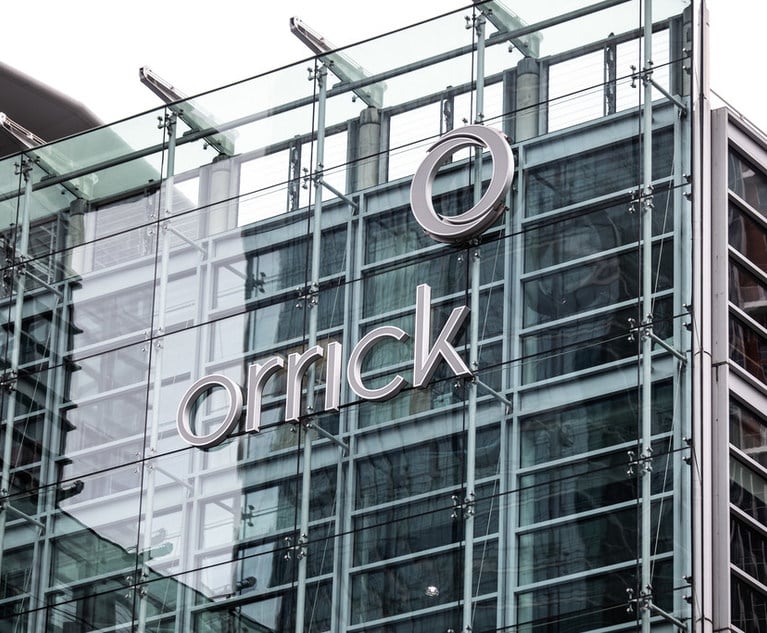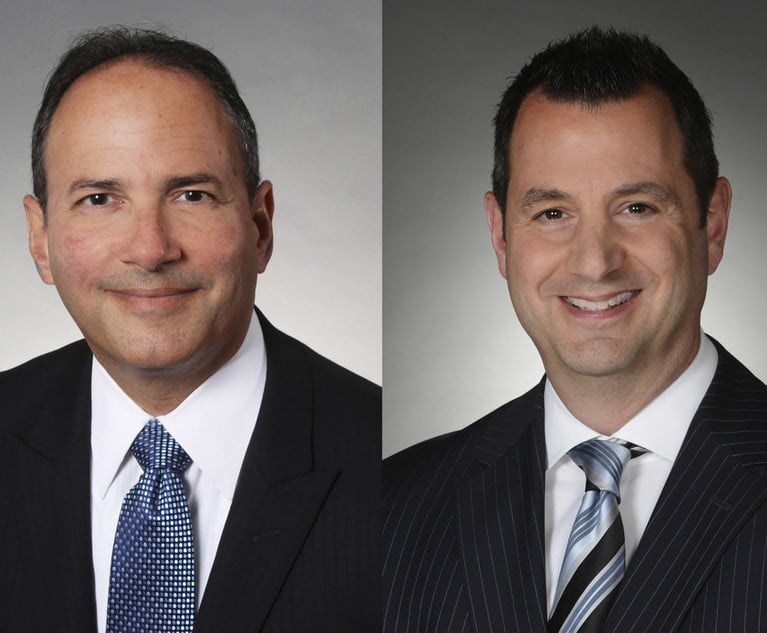Pressed for Progress: Clients Expect Firms to Meet Their Demands for Talent in 2020
Experts in the space of talent and diversity spoke with The American Lawyer about what trends will come to the fore in 2020.
January 02, 2020 at 02:00 PM
4 minute read
 Credit: William Brown
Credit: William Brown
Clients will continue to push the pace of progress at law firms in the new year, urging them to diversify their ranks and, in turn, find new methods to recruit the right lawyers.
There has been significant movement in the diversity space of late, after more than 200 general counsel, led by Turo chief legal officer Michelle Fang, catalyzed a broad client push to bring more diverse teams into their matters last year.
Yusuf Zakir, director of diversity and inclusion at Holland & Knight, says client pressure isn't going away anytime soon, and firms will have to continue to improve or risk losing business.
"More clients than not will be making those demands, and we will reach a tipping point that will require firms to make structural changes," Zakir says.
One major change he's expecting is a re-examination of how firms expect attorneys to fit with their culture, a theme of this year's annual conference of the Association of Law Firm Diversity Professionals.
"Traditionally at law firms, we've tended to think of the concept of 'fit.' I think that's fading with time," Zakir says. "We know that that sort of thinking leads to biased decision-making. Firms are going to move toward allowing people to be themselves in their space."
The push to diversify teams will also bring wholesale changes to the recruiting and interview process, experts say. Four years ago, Thompson Hine collaborated with a team of social scientists and experts to revamp their interview process in an attempt to remove pernicious unconscious bias. Partners were given a personality test, which was then fed to the scientists to develop an index of traits that successful partners exhibit.
Candidates applying to the firm are asked to take a personality and legal writing test. Results are then overlaid on a "success index" to see how their behaviors align with empirically proven successful traits. Candidates are then brought in for two rounds of interviews, beginning with a single, structured interview and a paneled interview where each candidate is asked the same set of questions.
All these steps are taken to ensure that the interview process involves as little implicit bias as possible, says Thompson Hine's chief talent officer Andy Colón.
The first summer associate class that went through the new interview process was the most diverse the firm has ever had, Colón says. Around 70% of the 2L class was racially diverse. The numbers stayed strong, with 60% of the following year's class being racially diverse.
"Assuming that summer associates are offered a position, we'll have a wonderful pipeline in the coming years," he said. "It has worked so well that we extended it to all non-partner hires, including laterals."
Colón spoke about the new process, which has been standard for more than a decade among the Big Four accounting firms, at a conference panel in April attended by more than 200 law firm leaders. Nobody raised a hand when asked if their own firms employed a similar system. But Colón believes more firms will adopt the process in the coming year.
Milbank's extremely early announcement of their associate bonuses in the first week of November is a signal that the battle for talent will not subside in the year to come. Experts, including Harvard Law School professor Scott Westfahl, suggest that firms are looking to woo top talent, not just by raising salaries but by meaningfully changing their work experience.
Whether it be better parental leave or robust training programs, firms will look to differentiate themselves in ways more sustainable and long term than raises, he says. Another interesting trend the industry will likely see in 2020 is an emphasis on allowing attorneys to unplug when they're on vacation.
"Professionals in corporate law firms are expecting that they're going to work hard and understand that," Westfahl says. "What firms have not been able to achieve is giving junior people more predictability in their work schedules. And the ability to disengage and be offline—truly offline."
This content has been archived. It is available through our partners, LexisNexis® and Bloomberg Law.
To view this content, please continue to their sites.
Not a Lexis Subscriber?
Subscribe Now
Not a Bloomberg Law Subscriber?
Subscribe Now
NOT FOR REPRINT
© 2025 ALM Global, LLC, All Rights Reserved. Request academic re-use from www.copyright.com. All other uses, submit a request to [email protected]. For more information visit Asset & Logo Licensing.
You Might Like
View All
Milbank’s Revenue and Profits Surge Following Demand Increases Across the Board
4 minute read
Fourth Quarter Growth in Demand and Worked Rates Coincided with Countercyclical Dip, New Report Indicates

Orrick Picks Up 13-Lawyer Tech, VC Group From Gunderson Dettmer

Saul Ewing Loses Two Partners to Fox Rothschild, Marking Four Fla. Partner Exits in Last 13 Months
3 minute readLaw Firms Mentioned
Trending Stories
- 1Connecticut Movers: New Laterals, Expanding Teams
- 2Eliminating Judicial Exceptions: The Promise of the Patent Eligibility Restoration Act
- 3AI in Legal: Disruptive Potential and Practical Realities
- 4One Court’s Opinion on Successfully Bankruptcy Proofing a Borrower
- 5Making the Case for Workflow Automation
Who Got The Work
J. Brugh Lower of Gibbons has entered an appearance for industrial equipment supplier Devco Corporation in a pending trademark infringement lawsuit. The suit, accusing the defendant of selling knock-off Graco products, was filed Dec. 18 in New Jersey District Court by Rivkin Radler on behalf of Graco Inc. and Graco Minnesota. The case, assigned to U.S. District Judge Zahid N. Quraishi, is 3:24-cv-11294, Graco Inc. et al v. Devco Corporation.
Who Got The Work
Rebecca Maller-Stein and Kent A. Yalowitz of Arnold & Porter Kaye Scholer have entered their appearances for Hanaco Venture Capital and its executives, Lior Prosor and David Frankel, in a pending securities lawsuit. The action, filed on Dec. 24 in New York Southern District Court by Zell, Aron & Co. on behalf of Goldeneye Advisors, accuses the defendants of negligently and fraudulently managing the plaintiff's $1 million investment. The case, assigned to U.S. District Judge Vernon S. Broderick, is 1:24-cv-09918, Goldeneye Advisors, LLC v. Hanaco Venture Capital, Ltd. et al.
Who Got The Work
Attorneys from A&O Shearman has stepped in as defense counsel for Toronto-Dominion Bank and other defendants in a pending securities class action. The suit, filed Dec. 11 in New York Southern District Court by Bleichmar Fonti & Auld, accuses the defendants of concealing the bank's 'pervasive' deficiencies in regards to its compliance with the Bank Secrecy Act and the quality of its anti-money laundering controls. The case, assigned to U.S. District Judge Arun Subramanian, is 1:24-cv-09445, Gonzalez v. The Toronto-Dominion Bank et al.
Who Got The Work
Crown Castle International, a Pennsylvania company providing shared communications infrastructure, has turned to Luke D. Wolf of Gordon Rees Scully Mansukhani to fend off a pending breach-of-contract lawsuit. The court action, filed Nov. 25 in Michigan Eastern District Court by Hooper Hathaway PC on behalf of The Town Residences LLC, accuses Crown Castle of failing to transfer approximately $30,000 in utility payments from T-Mobile in breach of a roof-top lease and assignment agreement. The case, assigned to U.S. District Judge Susan K. Declercq, is 2:24-cv-13131, The Town Residences LLC v. T-Mobile US, Inc. et al.
Who Got The Work
Wilfred P. Coronato and Daniel M. Schwartz of McCarter & English have stepped in as defense counsel to Electrolux Home Products Inc. in a pending product liability lawsuit. The court action, filed Nov. 26 in New York Eastern District Court by Poulos Lopiccolo PC and Nagel Rice LLP on behalf of David Stern, alleges that the defendant's refrigerators’ drawers and shelving repeatedly break and fall apart within months after purchase. The case, assigned to U.S. District Judge Joan M. Azrack, is 2:24-cv-08204, Stern v. Electrolux Home Products, Inc.
Featured Firms
Law Offices of Gary Martin Hays & Associates, P.C.
(470) 294-1674
Law Offices of Mark E. Salomone
(857) 444-6468
Smith & Hassler
(713) 739-1250










